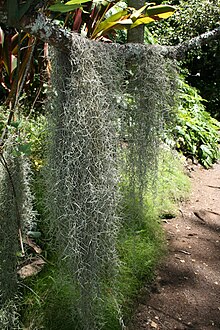| Spanish moss | |
|---|---|

| |
| Scientific classification | |
| Kingdom: | Plantae |
| Clade: | Tracheophytes |
| Clade: | Angiosperms |
| Clade: | Monocots |
| Clade: | Commelinids |
| Order: | Poales |
| Family: | Bromeliaceae |
| Genus: | Tillandsia |
| Subgenus: | Tillandsia subg. Diaphoranthema |
| Species: | T. usneoides
|
| Binomial name | |
| Tillandsia usneoides | |
| Synonyms[3] | |
| |
Spanish moss (Tillandsia usneoides) is an epiphytic flowering plant that often grows upon large trees in tropical and subtropical climates. It is native to much of Mexico, Bermuda, the Bahamas, Central America, South America, the Southern United States, and West Indies. It has been naturalized in Queensland (Australia). It is known as "grandpa's beard" in French Polynesia.[3]
Most known in the United States, it commonly is found on the southern live oak (Quercus virginiana) and bald cypress (Taxodium distichum) in the lowlands, swamps, and marshes of the mid-Atlantic and Southeastern states, from the coast of southeastern Virginia to Florida and west to southern Arkansas and Texas.[4][5] While it superficially resembles its namesake, the lichen Usnea, it is neither a lichen nor a moss (instead being a member of the Bromeliad family), and it is not native to Spain.
- ^ Treviño Zevallos, I. (2019). "Tillandsia usneoides". IUCN Red List of Threatened Species. 2019: e.T131368905A131369229. doi:10.2305/IUCN.UK.2019-3.RLTS.T131368905A131369229.en. Retrieved 16 October 2022.
- ^ "Tillandsia usneoides". Germplasm Resources Information Network. Agricultural Research Service, United States Department of Agriculture. Retrieved 2009-12-08.
- ^ a b Kew World Checklist of Selected Plant Families, Tillandsia usneoides
- ^ Luther, Harry E.; Brown, Gregory K. (2000). "Tillandsia usneoides". In Flora of North America Editorial Committee (ed.). Flora of North America North of Mexico (FNA). Vol. 22. New York and Oxford: Oxford University Press – via eFloras.org, Missouri Botanical Garden, St. Louis, MO & Harvard University Herbaria, Cambridge, MA.
- ^ "Tillandsia usneoides". County-level distribution map from the North American Plant Atlas (NAPA). Biota of North America Program (BONAP). 2014.
